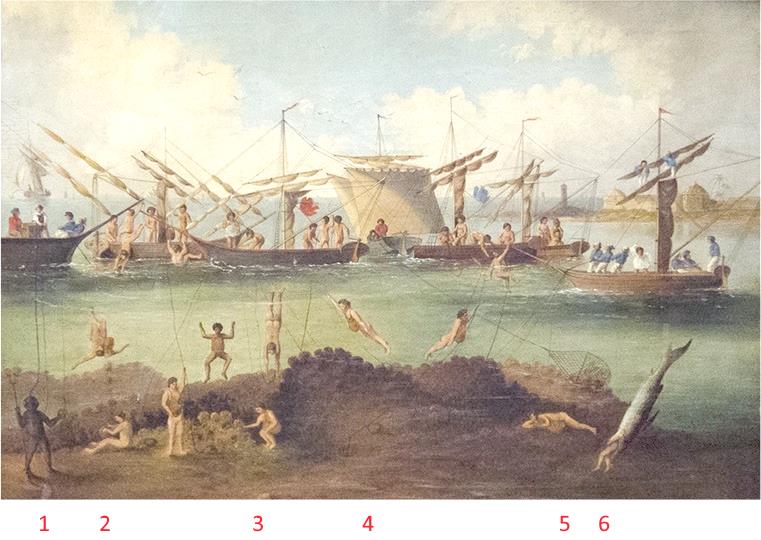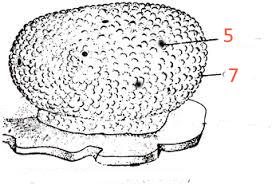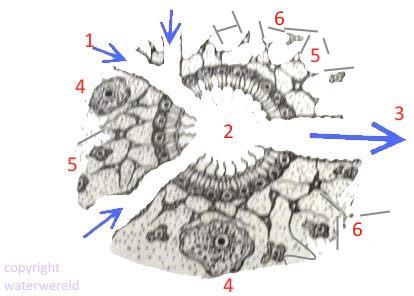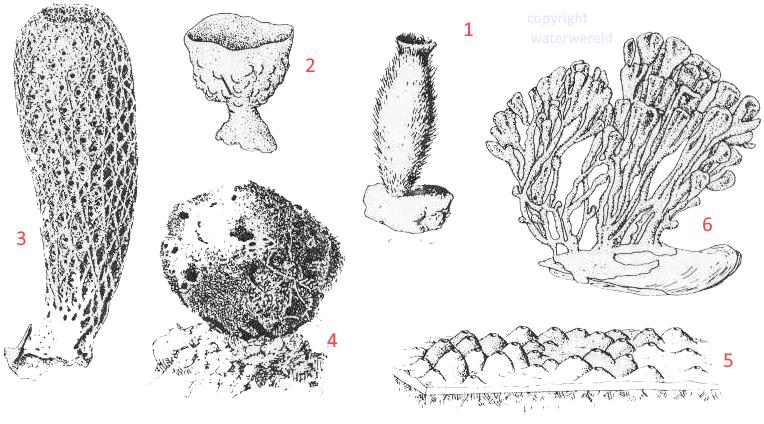Mediterranean Bath Sponge
The Mediterranean Bath Sponge has been collected and processed for use as a bath sponge , already for more then 4000 years. It grows in round cushions and mounds. Its is dark grey from the outside , the core is yellowish white. After drying and processing the whole spomge becomes light colored. The bath sponge doesn’t contain the sharp specules that make op the skeleton of other sponges, but only contains spongin : strong elastic fibers. Nowadays it is only possible to find this sponge rarely at an depth of 40 meter and more. But once there used to be large bath sponges just under the surface.
The Bath Sponge has been replaced
Nowadays the Bath Sponge isn’t used any more: Sponges in the Gulf of (Demospongiae) are used nowadays for this purpose. The Luffa, a vegetable, has a spongelike skeleton that is used in the same way. Artificial produced and non-natural sponges are nowadays much more common, cheaper and also more hygienic.

1 Bath Sponge, Mediterranean sponge or Greek Sponge or euspongia officinalis.
2 the sponge Suberites domuncula and a hermit crab (3), have a mutalistic association The hermit crab live in the shells of a gastropod mollusks. The advantage to the sponge is that it is carried by the mollusk; the hermit crab gains protection not only by living in the shell of the mollusk but also through the disagreeable smell and taste of the sponge, which discourages attack by fishes and other enemies
4 Sycon raphanus is a calcareous sponge belonging to the family Sycettidaea.
5 Yellow Tube Spong or Aplysina Aerophoba
6 Sycon species
Diving for the sea sponge
The oldest way of collecting bath sponges was done around the Greek islands by divers. They collect the sponge by cutting off the sea bottom at there base. During many centuries there was no progress at all in the way the sponges were collected although it became harder to find large bath sponges: there are very slow growers.

1 North african slave with an fork , used for attaching sponges.
2 Filling a basket with sponges
3 Gathering of nude divers around a large groupe of bath sponges: those big songes don’t exist any more.
4 being pulled to the surface with an basket full of sponges. Also towing a net
filled with sponges
5 removing a sponge by cutting off at the base.
6 there are many dangers for the divers, like drowning or being eaten by a shark.

Sponges
Sponges are the simplest form of multi-cellular animals. These cells live together in a skeleton and filter tiny food particles from the water (filter feeder). Sponge don´t move, they stay attached to the bottom.
choanocytes or collar cells
These cells filter the particle out of the water. They propel the water with the use of a flagellum. All these flagella move in a coordinated way together and produce a water current. The water enters through pores the sponge from the outside to a
They’re also filter feeders that strain tiny food particles from the water, using specialized types of cells called choanocytes or collar cells, which line their interior surfaces. These cells have a mesh-like collar at one end that encircles a tiny whip-like structure called a flagellum, and when thousands of them simultaneously wiggle these whips it creates a current of water. This current moves water (and food particles carried in it) from the outside into the sponge’s body through numerous tiny openings, called ostia, then through lots of very tiny canals in the body, and then into a larger internal chamber called an atrium. From there it passes out of a relatively large opening, called an osculum, back to the environment.
how to use a bath sponge
When dried, the sponge will discolor from almost black to light yellow. Don’t use the natural bath sponge inside the vagina: it contains pyogenic bacteria that can’t be removed. Rinse with clean water and gently squeeze dry it after each use. Never wring it out.
Anatomy of the bath sponge
The water collects in a hole called spongocoel 2
The spongocoel is covered with cells that propels the water and feed on the plancton, these cells are called choanocyt, but mostly called collar cells 7.
The filtered water leaves through the 5 osculum.
There are free moving 3 sclerocyts that forms the spiculae 9, the skeleton of the sponge.


Bath sponge skeleton
The skeleton of the sponge consist of spicules: filaments made of silica and produced by the sclerocytes, specialized cells.These sclerocytes secrete those spicules by deposing silica around an organic filament. Sponges are the only animals that are capable of using silica. In Demospongiae, like the bath sponge ,the spicules are glued together by a collagenous ‘cement’ made of microfibrils.(4)

The phylum of sponges consist of three distinct classes :
Class Calcarea These sponges have a skeleton made of calcium carbonate spicules. they inhabit shallow waters of all seas and are usually small.
1 Scyphia or Sycon
.
2 after Lankester , treatise on Zoology, A. & C. black . ltd.
Sources
source
1 An illustration made for Alfred Brehms by Flandersky,
2 after Lankester , treatise on Zoology, A. & C. black . ltd.
4 W. E. G. Müller et all, aug 2000 Expression of silicatein and collagen genes in the marine sponge Suberites domuncula is controlled by silicate and myotrophin
